Integrative Leadership Paper: Solving Challenges within McKinsey
VerifiedAdded on 2023/06/04
|10
|2516
|479
Report
AI Summary
This report identifies and analyzes leadership challenges within McKinsey & Co., focusing on issues such as decoupling reflection from real work, underestimating diverse mindsets, and failing to measure results. It reviews relevant literature and leadership theories, including situational, transformational, and contingency theories, to propose integrative strategies for improving organizational health and leadership effectiveness. The report emphasizes the importance of aligning leadership skills with organizational context, fostering employee-driven solutions, and reinforcing changes through formalized mechanisms. The ultimate goal is to provide actionable insights for McKinsey to address its leadership gaps and enhance overall performance. Desklib provides similar solved assignments and past papers for students.
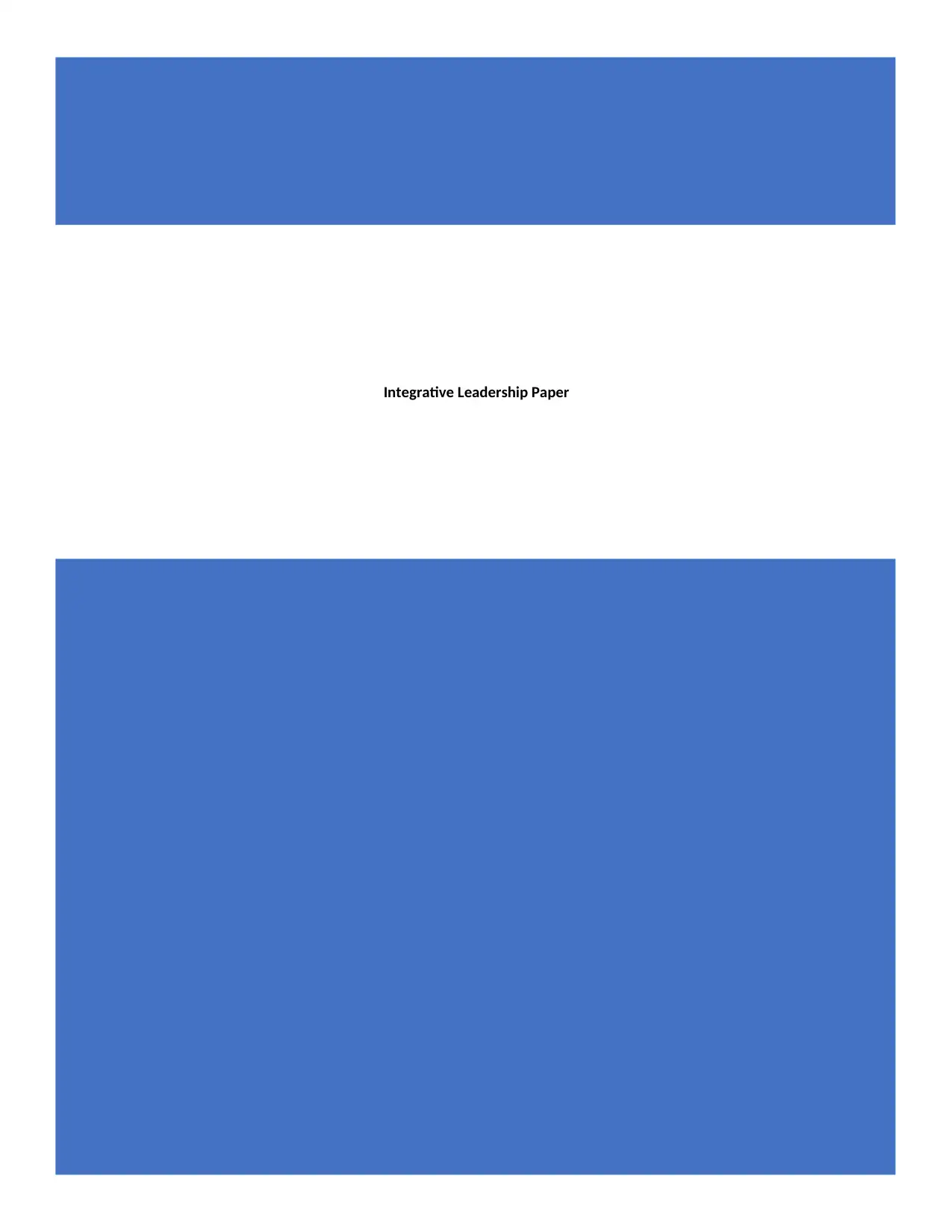
Integrative Leadership Paper
Paraphrase This Document
Need a fresh take? Get an instant paraphrase of this document with our AI Paraphraser
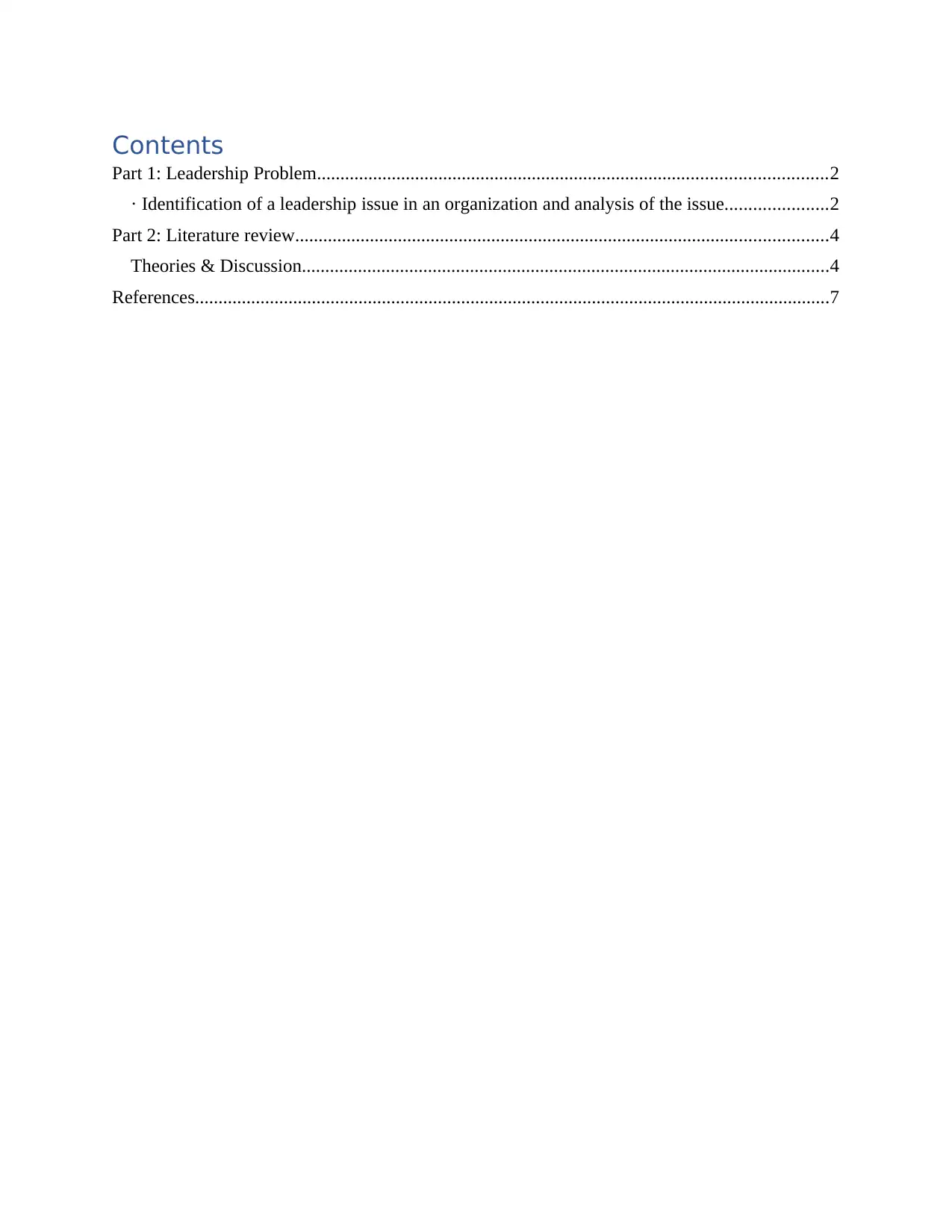
Contents
Part 1: Leadership Problem.............................................................................................................2
· Identification of a leadership issue in an organization and analysis of the issue......................2
Part 2: Literature review..................................................................................................................4
Theories & Discussion.................................................................................................................4
References........................................................................................................................................7
Part 1: Leadership Problem.............................................................................................................2
· Identification of a leadership issue in an organization and analysis of the issue......................2
Part 2: Literature review..................................................................................................................4
Theories & Discussion.................................................................................................................4
References........................................................................................................................................7
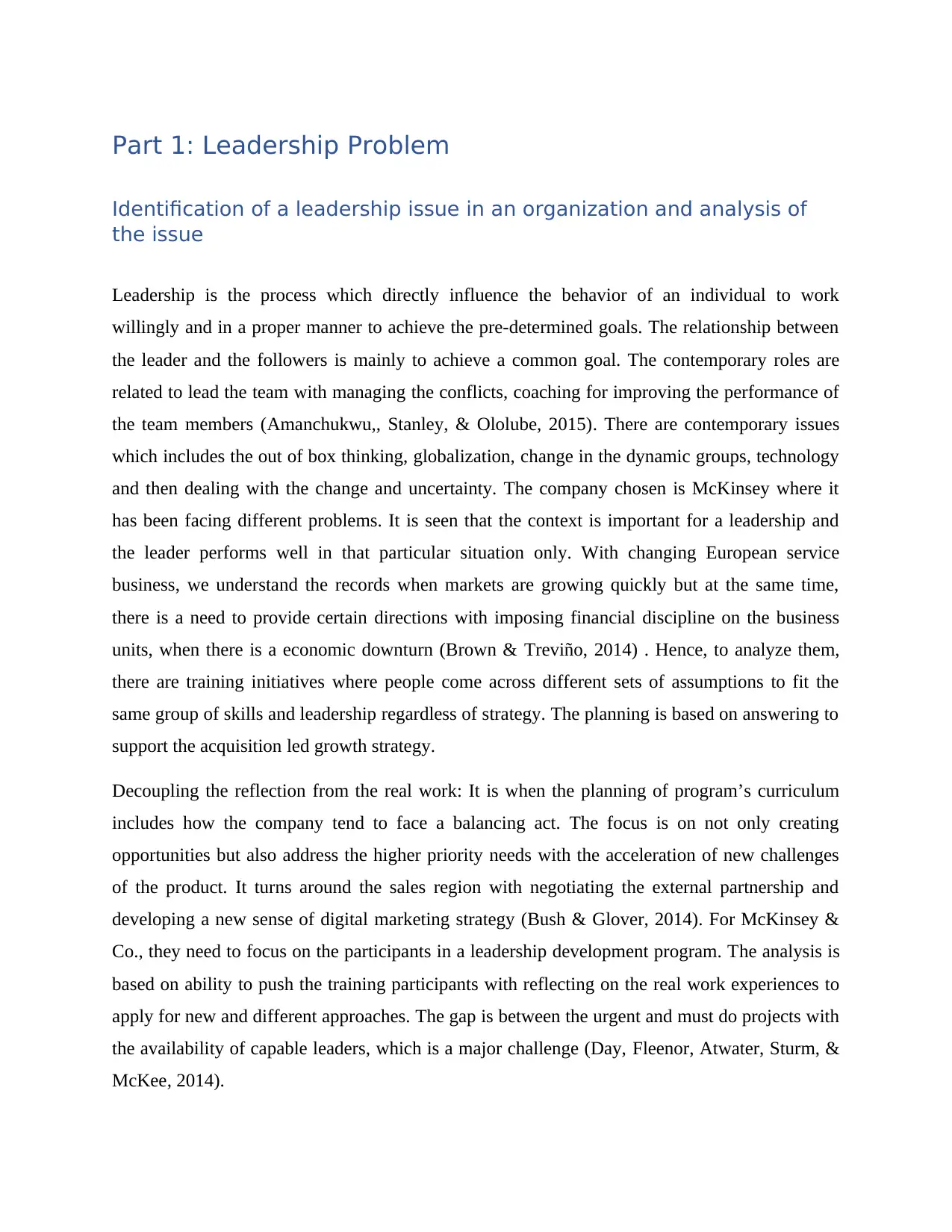
Part 1: Leadership Problem
Identification of a leadership issue in an organization and analysis of
the issue
Leadership is the process which directly influence the behavior of an individual to work
willingly and in a proper manner to achieve the pre-determined goals. The relationship between
the leader and the followers is mainly to achieve a common goal. The contemporary roles are
related to lead the team with managing the conflicts, coaching for improving the performance of
the team members (Amanchukwu,, Stanley, & Ololube, 2015). There are contemporary issues
which includes the out of box thinking, globalization, change in the dynamic groups, technology
and then dealing with the change and uncertainty. The company chosen is McKinsey where it
has been facing different problems. It is seen that the context is important for a leadership and
the leader performs well in that particular situation only. With changing European service
business, we understand the records when markets are growing quickly but at the same time,
there is a need to provide certain directions with imposing financial discipline on the business
units, when there is a economic downturn (Brown & Treviño, 2014) . Hence, to analyze them,
there are training initiatives where people come across different sets of assumptions to fit the
same group of skills and leadership regardless of strategy. The planning is based on answering to
support the acquisition led growth strategy.
Decoupling the reflection from the real work: It is when the planning of program’s curriculum
includes how the company tend to face a balancing act. The focus is on not only creating
opportunities but also address the higher priority needs with the acceleration of new challenges
of the product. It turns around the sales region with negotiating the external partnership and
developing a new sense of digital marketing strategy (Bush & Glover, 2014). For McKinsey &
Co., they need to focus on the participants in a leadership development program. The analysis is
based on ability to push the training participants with reflecting on the real work experiences to
apply for new and different approaches. The gap is between the urgent and must do projects with
the availability of capable leaders, which is a major challenge (Day, Fleenor, Atwater, Sturm, &
McKee, 2014).
Identification of a leadership issue in an organization and analysis of
the issue
Leadership is the process which directly influence the behavior of an individual to work
willingly and in a proper manner to achieve the pre-determined goals. The relationship between
the leader and the followers is mainly to achieve a common goal. The contemporary roles are
related to lead the team with managing the conflicts, coaching for improving the performance of
the team members (Amanchukwu,, Stanley, & Ololube, 2015). There are contemporary issues
which includes the out of box thinking, globalization, change in the dynamic groups, technology
and then dealing with the change and uncertainty. The company chosen is McKinsey where it
has been facing different problems. It is seen that the context is important for a leadership and
the leader performs well in that particular situation only. With changing European service
business, we understand the records when markets are growing quickly but at the same time,
there is a need to provide certain directions with imposing financial discipline on the business
units, when there is a economic downturn (Brown & Treviño, 2014) . Hence, to analyze them,
there are training initiatives where people come across different sets of assumptions to fit the
same group of skills and leadership regardless of strategy. The planning is based on answering to
support the acquisition led growth strategy.
Decoupling the reflection from the real work: It is when the planning of program’s curriculum
includes how the company tend to face a balancing act. The focus is on not only creating
opportunities but also address the higher priority needs with the acceleration of new challenges
of the product. It turns around the sales region with negotiating the external partnership and
developing a new sense of digital marketing strategy (Bush & Glover, 2014). For McKinsey &
Co., they need to focus on the participants in a leadership development program. The analysis is
based on ability to push the training participants with reflecting on the real work experiences to
apply for new and different approaches. The gap is between the urgent and must do projects with
the availability of capable leaders, which is a major challenge (Day, Fleenor, Atwater, Sturm, &
McKee, 2014).
⊘ This is a preview!⊘
Do you want full access?
Subscribe today to unlock all pages.

Trusted by 1+ million students worldwide
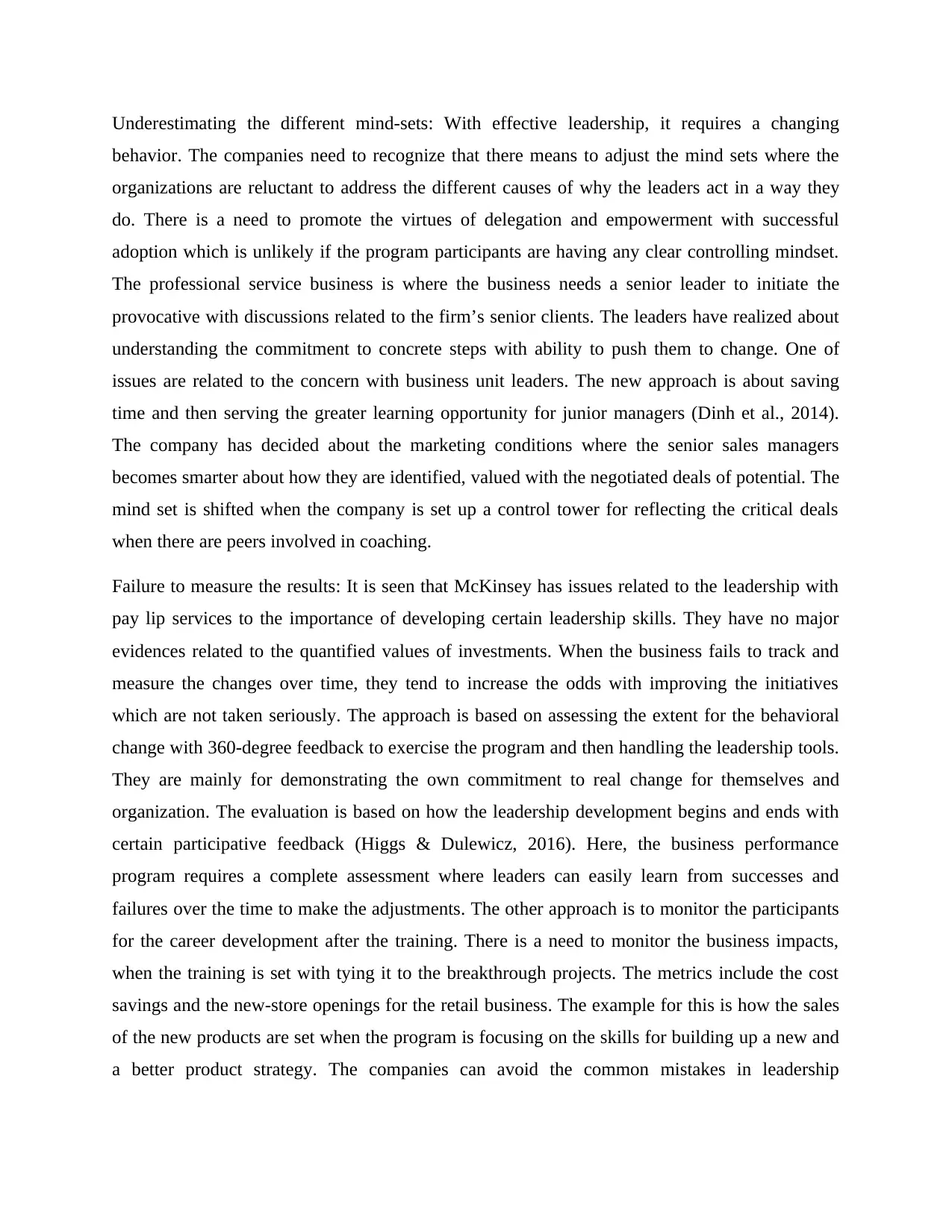
Underestimating the different mind-sets: With effective leadership, it requires a changing
behavior. The companies need to recognize that there means to adjust the mind sets where the
organizations are reluctant to address the different causes of why the leaders act in a way they
do. There is a need to promote the virtues of delegation and empowerment with successful
adoption which is unlikely if the program participants are having any clear controlling mindset.
The professional service business is where the business needs a senior leader to initiate the
provocative with discussions related to the firm’s senior clients. The leaders have realized about
understanding the commitment to concrete steps with ability to push them to change. One of
issues are related to the concern with business unit leaders. The new approach is about saving
time and then serving the greater learning opportunity for junior managers (Dinh et al., 2014).
The company has decided about the marketing conditions where the senior sales managers
becomes smarter about how they are identified, valued with the negotiated deals of potential. The
mind set is shifted when the company is set up a control tower for reflecting the critical deals
when there are peers involved in coaching.
Failure to measure the results: It is seen that McKinsey has issues related to the leadership with
pay lip services to the importance of developing certain leadership skills. They have no major
evidences related to the quantified values of investments. When the business fails to track and
measure the changes over time, they tend to increase the odds with improving the initiatives
which are not taken seriously. The approach is based on assessing the extent for the behavioral
change with 360-degree feedback to exercise the program and then handling the leadership tools.
They are mainly for demonstrating the own commitment to real change for themselves and
organization. The evaluation is based on how the leadership development begins and ends with
certain participative feedback (Higgs & Dulewicz, 2016). Here, the business performance
program requires a complete assessment where leaders can easily learn from successes and
failures over the time to make the adjustments. The other approach is to monitor the participants
for the career development after the training. There is a need to monitor the business impacts,
when the training is set with tying it to the breakthrough projects. The metrics include the cost
savings and the new-store openings for the retail business. The example for this is how the sales
of the new products are set when the program is focusing on the skills for building up a new and
a better product strategy. The companies can avoid the common mistakes in leadership
behavior. The companies need to recognize that there means to adjust the mind sets where the
organizations are reluctant to address the different causes of why the leaders act in a way they
do. There is a need to promote the virtues of delegation and empowerment with successful
adoption which is unlikely if the program participants are having any clear controlling mindset.
The professional service business is where the business needs a senior leader to initiate the
provocative with discussions related to the firm’s senior clients. The leaders have realized about
understanding the commitment to concrete steps with ability to push them to change. One of
issues are related to the concern with business unit leaders. The new approach is about saving
time and then serving the greater learning opportunity for junior managers (Dinh et al., 2014).
The company has decided about the marketing conditions where the senior sales managers
becomes smarter about how they are identified, valued with the negotiated deals of potential. The
mind set is shifted when the company is set up a control tower for reflecting the critical deals
when there are peers involved in coaching.
Failure to measure the results: It is seen that McKinsey has issues related to the leadership with
pay lip services to the importance of developing certain leadership skills. They have no major
evidences related to the quantified values of investments. When the business fails to track and
measure the changes over time, they tend to increase the odds with improving the initiatives
which are not taken seriously. The approach is based on assessing the extent for the behavioral
change with 360-degree feedback to exercise the program and then handling the leadership tools.
They are mainly for demonstrating the own commitment to real change for themselves and
organization. The evaluation is based on how the leadership development begins and ends with
certain participative feedback (Higgs & Dulewicz, 2016). Here, the business performance
program requires a complete assessment where leaders can easily learn from successes and
failures over the time to make the adjustments. The other approach is to monitor the participants
for the career development after the training. There is a need to monitor the business impacts,
when the training is set with tying it to the breakthrough projects. The metrics include the cost
savings and the new-store openings for the retail business. The example for this is how the sales
of the new products are set when the program is focusing on the skills for building up a new and
a better product strategy. The companies can avoid the common mistakes in leadership
Paraphrase This Document
Need a fresh take? Get an instant paraphrase of this document with our AI Paraphraser
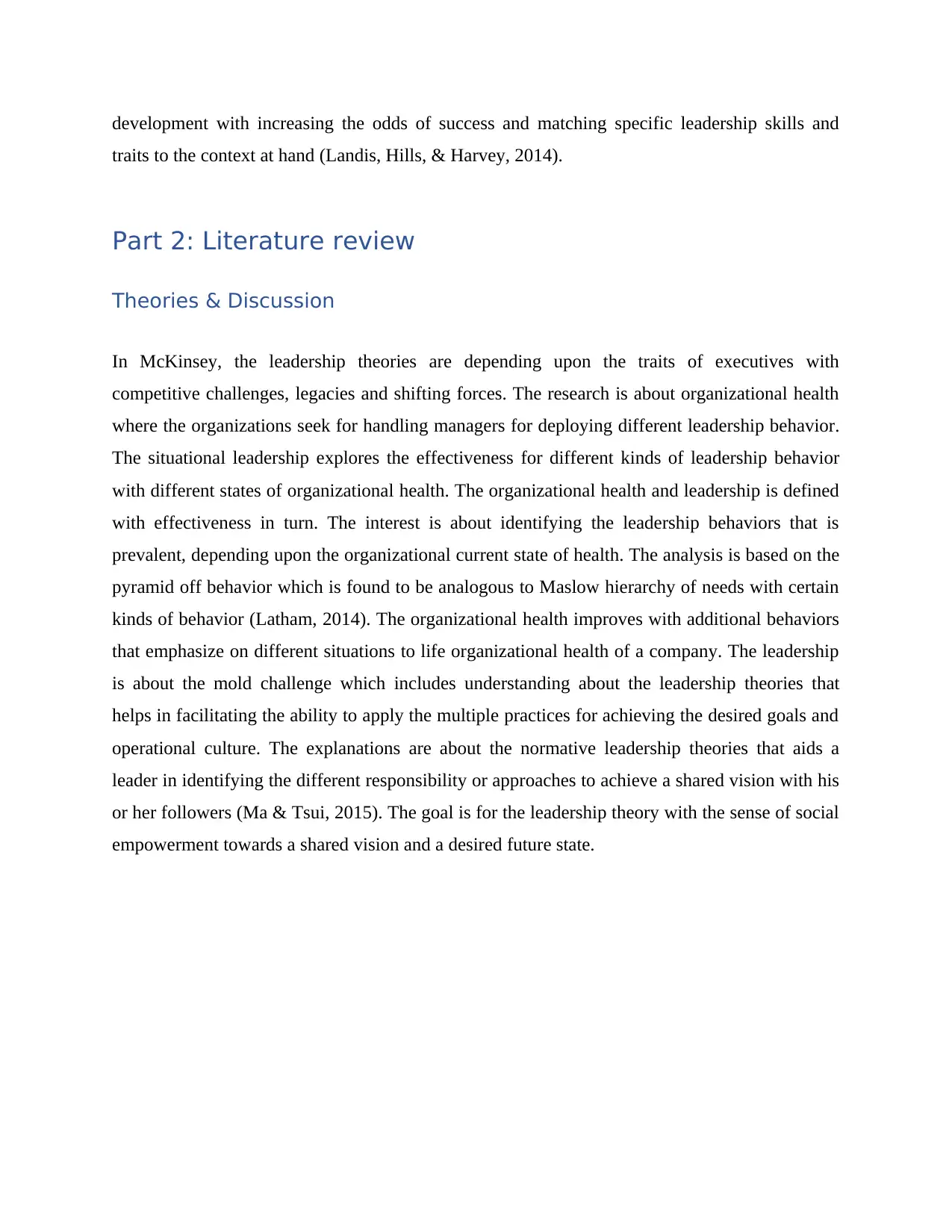
development with increasing the odds of success and matching specific leadership skills and
traits to the context at hand (Landis, Hills, & Harvey, 2014).
Part 2: Literature review
Theories & Discussion
In McKinsey, the leadership theories are depending upon the traits of executives with
competitive challenges, legacies and shifting forces. The research is about organizational health
where the organizations seek for handling managers for deploying different leadership behavior.
The situational leadership explores the effectiveness for different kinds of leadership behavior
with different states of organizational health. The organizational health and leadership is defined
with effectiveness in turn. The interest is about identifying the leadership behaviors that is
prevalent, depending upon the organizational current state of health. The analysis is based on the
pyramid off behavior which is found to be analogous to Maslow hierarchy of needs with certain
kinds of behavior (Latham, 2014). The organizational health improves with additional behaviors
that emphasize on different situations to life organizational health of a company. The leadership
is about the mold challenge which includes understanding about the leadership theories that
helps in facilitating the ability to apply the multiple practices for achieving the desired goals and
operational culture. The explanations are about the normative leadership theories that aids a
leader in identifying the different responsibility or approaches to achieve a shared vision with his
or her followers (Ma & Tsui, 2015). The goal is for the leadership theory with the sense of social
empowerment towards a shared vision and a desired future state.
traits to the context at hand (Landis, Hills, & Harvey, 2014).
Part 2: Literature review
Theories & Discussion
In McKinsey, the leadership theories are depending upon the traits of executives with
competitive challenges, legacies and shifting forces. The research is about organizational health
where the organizations seek for handling managers for deploying different leadership behavior.
The situational leadership explores the effectiveness for different kinds of leadership behavior
with different states of organizational health. The organizational health and leadership is defined
with effectiveness in turn. The interest is about identifying the leadership behaviors that is
prevalent, depending upon the organizational current state of health. The analysis is based on the
pyramid off behavior which is found to be analogous to Maslow hierarchy of needs with certain
kinds of behavior (Latham, 2014). The organizational health improves with additional behaviors
that emphasize on different situations to life organizational health of a company. The leadership
is about the mold challenge which includes understanding about the leadership theories that
helps in facilitating the ability to apply the multiple practices for achieving the desired goals and
operational culture. The explanations are about the normative leadership theories that aids a
leader in identifying the different responsibility or approaches to achieve a shared vision with his
or her followers (Ma & Tsui, 2015). The goal is for the leadership theory with the sense of social
empowerment towards a shared vision and a desired future state.
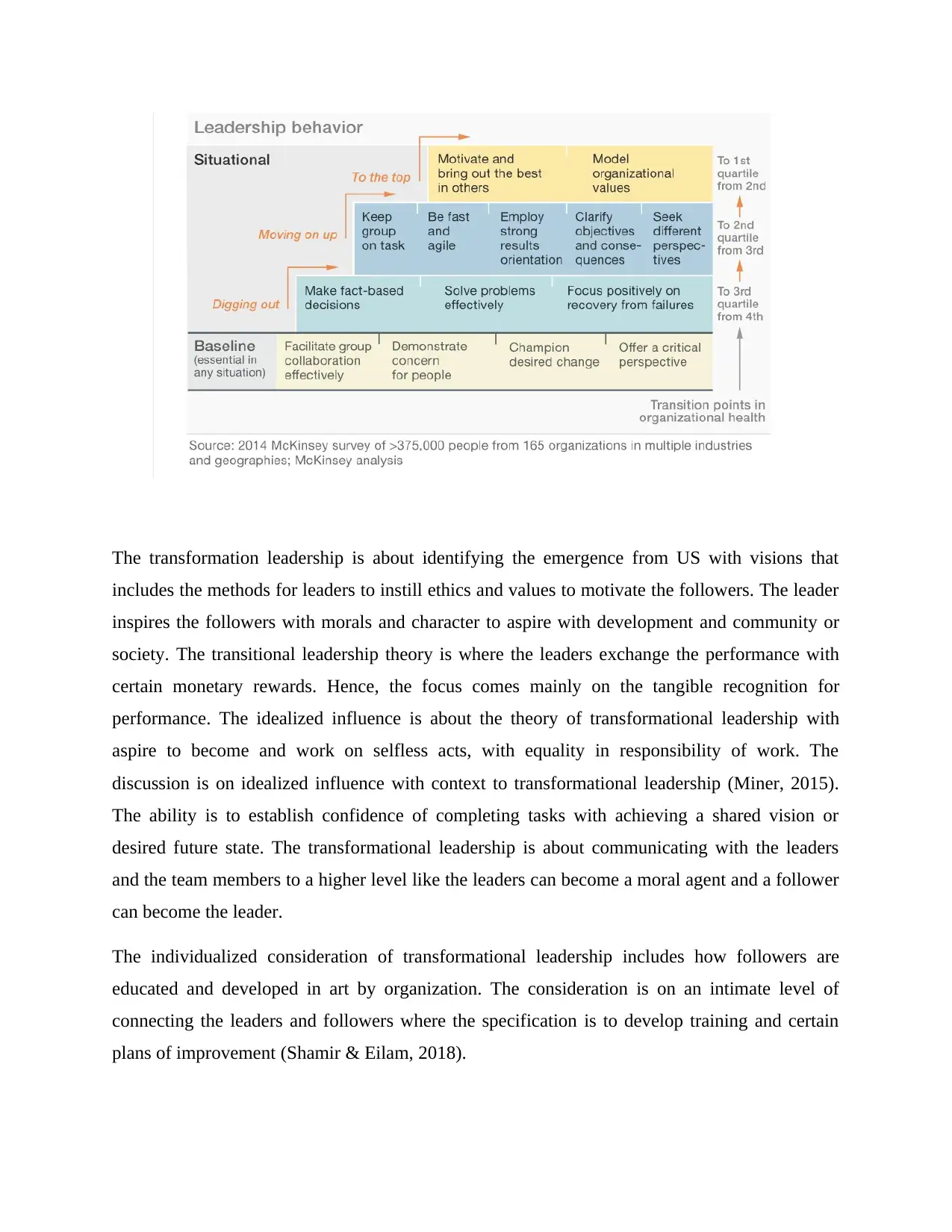
The transformation leadership is about identifying the emergence from US with visions that
includes the methods for leaders to instill ethics and values to motivate the followers. The leader
inspires the followers with morals and character to aspire with development and community or
society. The transitional leadership theory is where the leaders exchange the performance with
certain monetary rewards. Hence, the focus comes mainly on the tangible recognition for
performance. The idealized influence is about the theory of transformational leadership with
aspire to become and work on selfless acts, with equality in responsibility of work. The
discussion is on idealized influence with context to transformational leadership (Miner, 2015).
The ability is to establish confidence of completing tasks with achieving a shared vision or
desired future state. The transformational leadership is about communicating with the leaders
and the team members to a higher level like the leaders can become a moral agent and a follower
can become the leader.
The individualized consideration of transformational leadership includes how followers are
educated and developed in art by organization. The consideration is on an intimate level of
connecting the leaders and followers where the specification is to develop training and certain
plans of improvement (Shamir & Eilam, 2018).
includes the methods for leaders to instill ethics and values to motivate the followers. The leader
inspires the followers with morals and character to aspire with development and community or
society. The transitional leadership theory is where the leaders exchange the performance with
certain monetary rewards. Hence, the focus comes mainly on the tangible recognition for
performance. The idealized influence is about the theory of transformational leadership with
aspire to become and work on selfless acts, with equality in responsibility of work. The
discussion is on idealized influence with context to transformational leadership (Miner, 2015).
The ability is to establish confidence of completing tasks with achieving a shared vision or
desired future state. The transformational leadership is about communicating with the leaders
and the team members to a higher level like the leaders can become a moral agent and a follower
can become the leader.
The individualized consideration of transformational leadership includes how followers are
educated and developed in art by organization. The consideration is on an intimate level of
connecting the leaders and followers where the specification is to develop training and certain
plans of improvement (Shamir & Eilam, 2018).
⊘ This is a preview!⊘
Do you want full access?
Subscribe today to unlock all pages.

Trusted by 1+ million students worldwide
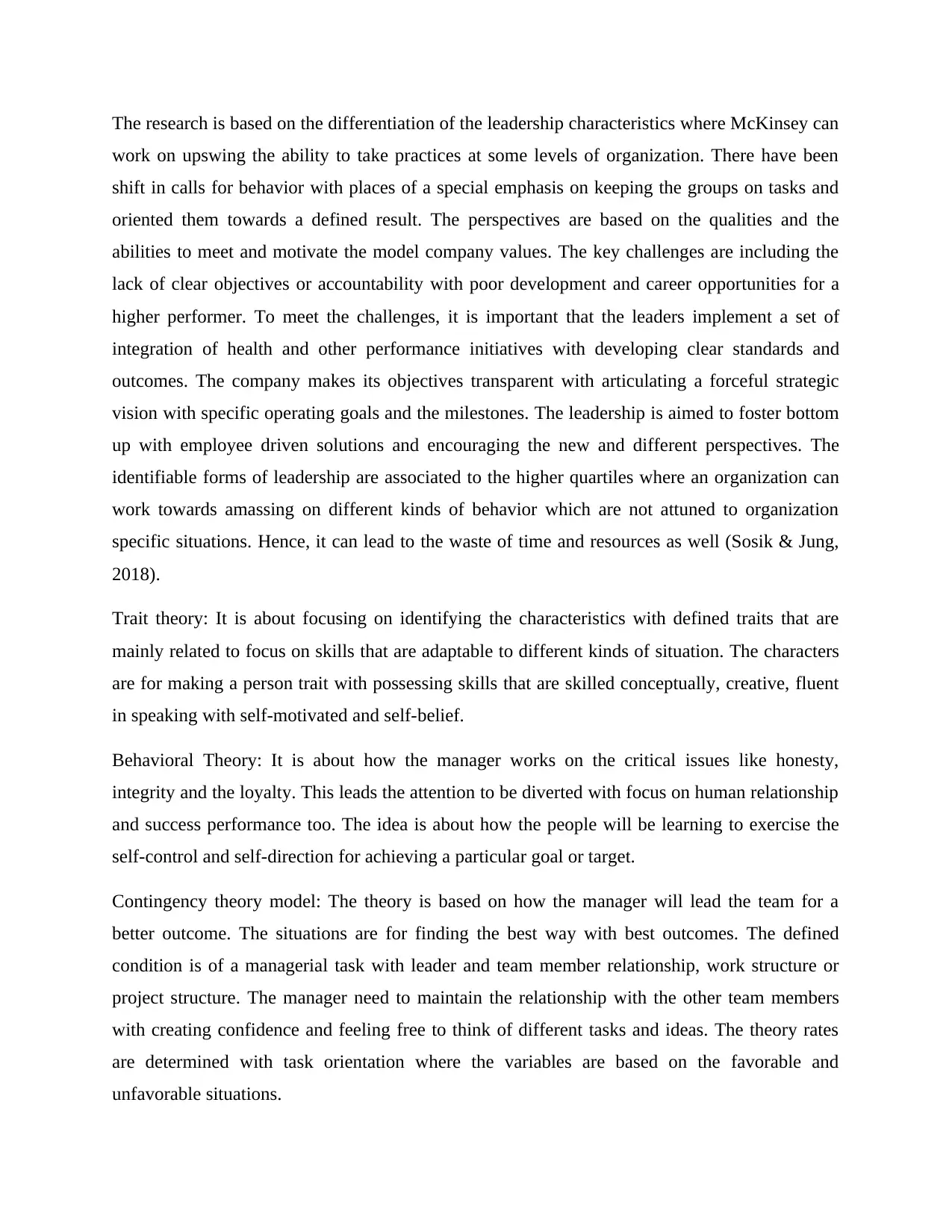
The research is based on the differentiation of the leadership characteristics where McKinsey can
work on upswing the ability to take practices at some levels of organization. There have been
shift in calls for behavior with places of a special emphasis on keeping the groups on tasks and
oriented them towards a defined result. The perspectives are based on the qualities and the
abilities to meet and motivate the model company values. The key challenges are including the
lack of clear objectives or accountability with poor development and career opportunities for a
higher performer. To meet the challenges, it is important that the leaders implement a set of
integration of health and other performance initiatives with developing clear standards and
outcomes. The company makes its objectives transparent with articulating a forceful strategic
vision with specific operating goals and the milestones. The leadership is aimed to foster bottom
up with employee driven solutions and encouraging the new and different perspectives. The
identifiable forms of leadership are associated to the higher quartiles where an organization can
work towards amassing on different kinds of behavior which are not attuned to organization
specific situations. Hence, it can lead to the waste of time and resources as well (Sosik & Jung,
2018).
Trait theory: It is about focusing on identifying the characteristics with defined traits that are
mainly related to focus on skills that are adaptable to different kinds of situation. The characters
are for making a person trait with possessing skills that are skilled conceptually, creative, fluent
in speaking with self-motivated and self-belief.
Behavioral Theory: It is about how the manager works on the critical issues like honesty,
integrity and the loyalty. This leads the attention to be diverted with focus on human relationship
and success performance too. The idea is about how the people will be learning to exercise the
self-control and self-direction for achieving a particular goal or target.
Contingency theory model: The theory is based on how the manager will lead the team for a
better outcome. The situations are for finding the best way with best outcomes. The defined
condition is of a managerial task with leader and team member relationship, work structure or
project structure. The manager need to maintain the relationship with the other team members
with creating confidence and feeling free to think of different tasks and ideas. The theory rates
are determined with task orientation where the variables are based on the favorable and
unfavorable situations.
work on upswing the ability to take practices at some levels of organization. There have been
shift in calls for behavior with places of a special emphasis on keeping the groups on tasks and
oriented them towards a defined result. The perspectives are based on the qualities and the
abilities to meet and motivate the model company values. The key challenges are including the
lack of clear objectives or accountability with poor development and career opportunities for a
higher performer. To meet the challenges, it is important that the leaders implement a set of
integration of health and other performance initiatives with developing clear standards and
outcomes. The company makes its objectives transparent with articulating a forceful strategic
vision with specific operating goals and the milestones. The leadership is aimed to foster bottom
up with employee driven solutions and encouraging the new and different perspectives. The
identifiable forms of leadership are associated to the higher quartiles where an organization can
work towards amassing on different kinds of behavior which are not attuned to organization
specific situations. Hence, it can lead to the waste of time and resources as well (Sosik & Jung,
2018).
Trait theory: It is about focusing on identifying the characteristics with defined traits that are
mainly related to focus on skills that are adaptable to different kinds of situation. The characters
are for making a person trait with possessing skills that are skilled conceptually, creative, fluent
in speaking with self-motivated and self-belief.
Behavioral Theory: It is about how the manager works on the critical issues like honesty,
integrity and the loyalty. This leads the attention to be diverted with focus on human relationship
and success performance too. The idea is about how the people will be learning to exercise the
self-control and self-direction for achieving a particular goal or target.
Contingency theory model: The theory is based on how the manager will lead the team for a
better outcome. The situations are for finding the best way with best outcomes. The defined
condition is of a managerial task with leader and team member relationship, work structure or
project structure. The manager need to maintain the relationship with the other team members
with creating confidence and feeling free to think of different tasks and ideas. The theory rates
are determined with task orientation where the variables are based on the favorable and
unfavorable situations.
Paraphrase This Document
Need a fresh take? Get an instant paraphrase of this document with our AI Paraphraser
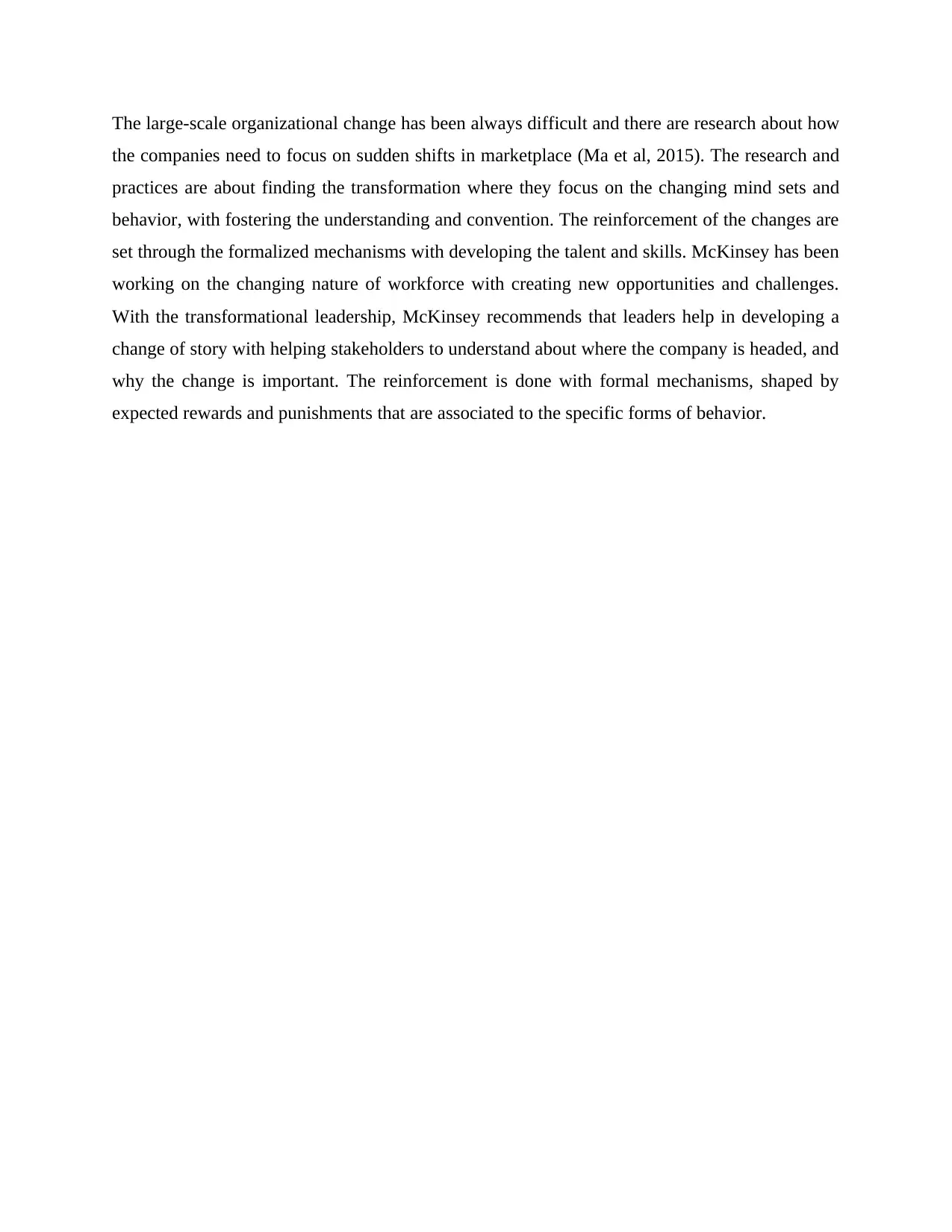
The large-scale organizational change has been always difficult and there are research about how
the companies need to focus on sudden shifts in marketplace (Ma et al, 2015). The research and
practices are about finding the transformation where they focus on the changing mind sets and
behavior, with fostering the understanding and convention. The reinforcement of the changes are
set through the formalized mechanisms with developing the talent and skills. McKinsey has been
working on the changing nature of workforce with creating new opportunities and challenges.
With the transformational leadership, McKinsey recommends that leaders help in developing a
change of story with helping stakeholders to understand about where the company is headed, and
why the change is important. The reinforcement is done with formal mechanisms, shaped by
expected rewards and punishments that are associated to the specific forms of behavior.
the companies need to focus on sudden shifts in marketplace (Ma et al, 2015). The research and
practices are about finding the transformation where they focus on the changing mind sets and
behavior, with fostering the understanding and convention. The reinforcement of the changes are
set through the formalized mechanisms with developing the talent and skills. McKinsey has been
working on the changing nature of workforce with creating new opportunities and challenges.
With the transformational leadership, McKinsey recommends that leaders help in developing a
change of story with helping stakeholders to understand about where the company is headed, and
why the change is important. The reinforcement is done with formal mechanisms, shaped by
expected rewards and punishments that are associated to the specific forms of behavior.
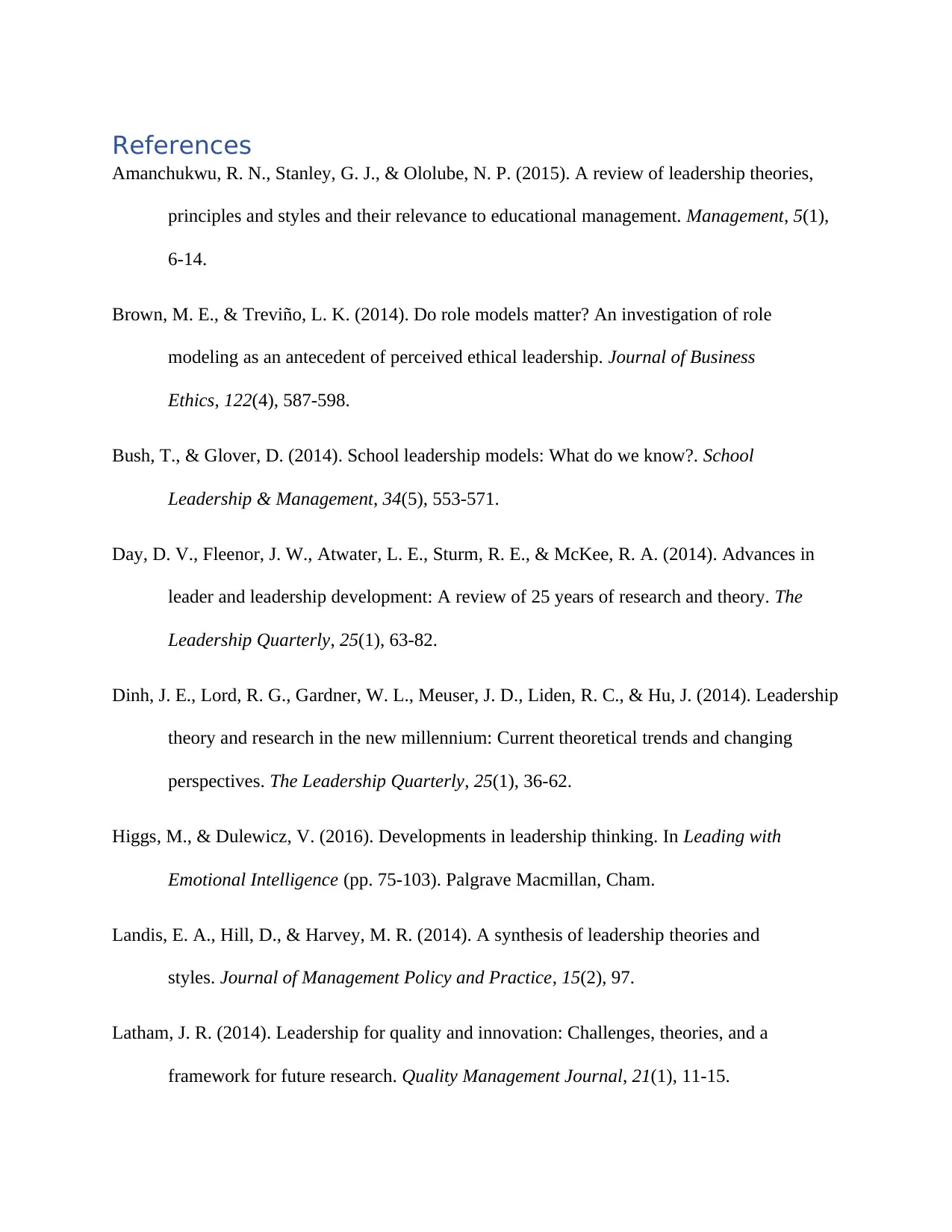
References
Amanchukwu, R. N., Stanley, G. J., & Ololube, N. P. (2015). A review of leadership theories,
principles and styles and their relevance to educational management. Management, 5(1),
6-14.
Brown, M. E., & Treviño, L. K. (2014). Do role models matter? An investigation of role
modeling as an antecedent of perceived ethical leadership. Journal of Business
Ethics, 122(4), 587-598.
Bush, T., & Glover, D. (2014). School leadership models: What do we know?. School
Leadership & Management, 34(5), 553-571.
Day, D. V., Fleenor, J. W., Atwater, L. E., Sturm, R. E., & McKee, R. A. (2014). Advances in
leader and leadership development: A review of 25 years of research and theory. The
Leadership Quarterly, 25(1), 63-82.
Dinh, J. E., Lord, R. G., Gardner, W. L., Meuser, J. D., Liden, R. C., & Hu, J. (2014). Leadership
theory and research in the new millennium: Current theoretical trends and changing
perspectives. The Leadership Quarterly, 25(1), 36-62.
Higgs, M., & Dulewicz, V. (2016). Developments in leadership thinking. In Leading with
Emotional Intelligence (pp. 75-103). Palgrave Macmillan, Cham.
Landis, E. A., Hill, D., & Harvey, M. R. (2014). A synthesis of leadership theories and
styles. Journal of Management Policy and Practice, 15(2), 97.
Latham, J. R. (2014). Leadership for quality and innovation: Challenges, theories, and a
framework for future research. Quality Management Journal, 21(1), 11-15.
Amanchukwu, R. N., Stanley, G. J., & Ololube, N. P. (2015). A review of leadership theories,
principles and styles and their relevance to educational management. Management, 5(1),
6-14.
Brown, M. E., & Treviño, L. K. (2014). Do role models matter? An investigation of role
modeling as an antecedent of perceived ethical leadership. Journal of Business
Ethics, 122(4), 587-598.
Bush, T., & Glover, D. (2014). School leadership models: What do we know?. School
Leadership & Management, 34(5), 553-571.
Day, D. V., Fleenor, J. W., Atwater, L. E., Sturm, R. E., & McKee, R. A. (2014). Advances in
leader and leadership development: A review of 25 years of research and theory. The
Leadership Quarterly, 25(1), 63-82.
Dinh, J. E., Lord, R. G., Gardner, W. L., Meuser, J. D., Liden, R. C., & Hu, J. (2014). Leadership
theory and research in the new millennium: Current theoretical trends and changing
perspectives. The Leadership Quarterly, 25(1), 36-62.
Higgs, M., & Dulewicz, V. (2016). Developments in leadership thinking. In Leading with
Emotional Intelligence (pp. 75-103). Palgrave Macmillan, Cham.
Landis, E. A., Hill, D., & Harvey, M. R. (2014). A synthesis of leadership theories and
styles. Journal of Management Policy and Practice, 15(2), 97.
Latham, J. R. (2014). Leadership for quality and innovation: Challenges, theories, and a
framework for future research. Quality Management Journal, 21(1), 11-15.
⊘ This is a preview!⊘
Do you want full access?
Subscribe today to unlock all pages.

Trusted by 1+ million students worldwide
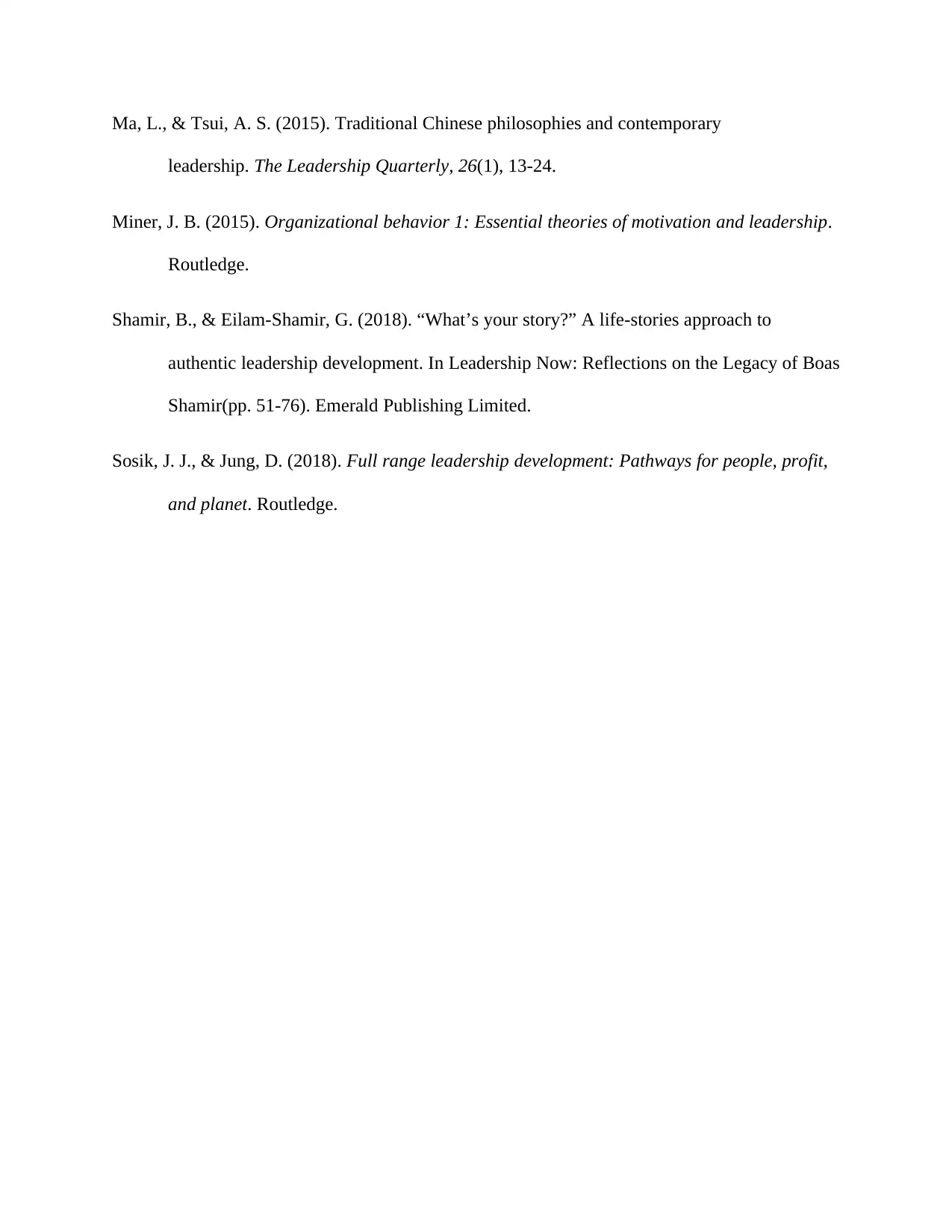
Ma, L., & Tsui, A. S. (2015). Traditional Chinese philosophies and contemporary
leadership. The Leadership Quarterly, 26(1), 13-24.
Miner, J. B. (2015). Organizational behavior 1: Essential theories of motivation and leadership.
Routledge.
Shamir, B., & Eilam-Shamir, G. (2018). “What’s your story?” A life-stories approach to
authentic leadership development. In Leadership Now: Reflections on the Legacy of Boas
Shamir(pp. 51-76). Emerald Publishing Limited.
Sosik, J. J., & Jung, D. (2018). Full range leadership development: Pathways for people, profit,
and planet. Routledge.
leadership. The Leadership Quarterly, 26(1), 13-24.
Miner, J. B. (2015). Organizational behavior 1: Essential theories of motivation and leadership.
Routledge.
Shamir, B., & Eilam-Shamir, G. (2018). “What’s your story?” A life-stories approach to
authentic leadership development. In Leadership Now: Reflections on the Legacy of Boas
Shamir(pp. 51-76). Emerald Publishing Limited.
Sosik, J. J., & Jung, D. (2018). Full range leadership development: Pathways for people, profit,
and planet. Routledge.
1 out of 10
Related Documents
Your All-in-One AI-Powered Toolkit for Academic Success.
+13062052269
info@desklib.com
Available 24*7 on WhatsApp / Email
![[object Object]](/_next/static/media/star-bottom.7253800d.svg)
Unlock your academic potential
Copyright © 2020–2025 A2Z Services. All Rights Reserved. Developed and managed by ZUCOL.





